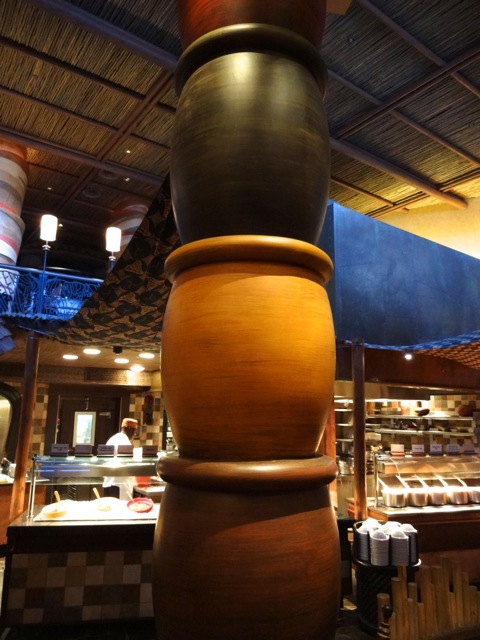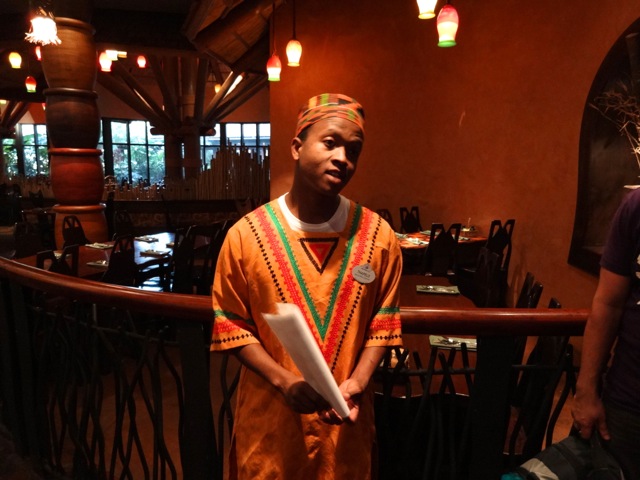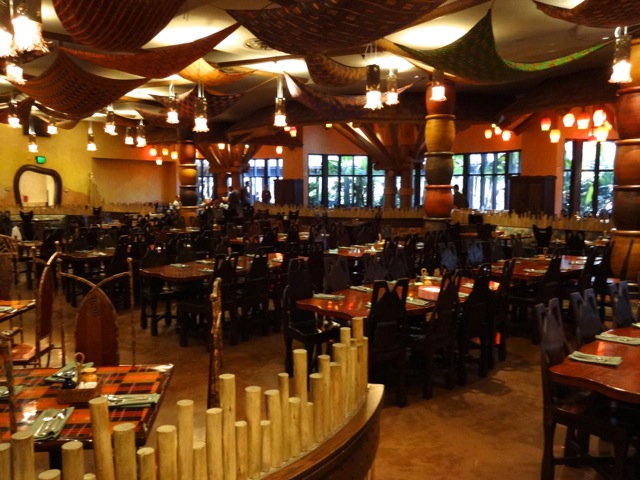The culinary tour of Boma at Jambo House, Animal Kingdom Lodge begins at 4:00 pm daily. You simply show up and wait in the seating area in front of the restaurant desk (it’s free).
We’ve only had breakfast at Boma (years ago when a friend visited from Martha’s Vineyard and we did a “no theme park tour of Walt Disney World”). We’ve stayed at Animal Kingdom Lodge (at that time there wasn’t a Kidani Village) twice, we ate at The Mara most of the time as we had a teenager traveling with us.
Our guide was Thapelo from Lesotho, South Africa – this country is very small and totally landlocked. Although it was a bit difficult to keep up and take notes, we had a lovely tour of Boma with him and strongly suggest that others take the tour.
WARNING – THERE ARE SPOILERS IN THIS BLOG POST – WARNING
WARNING – THERE IS LEARNING IN THIS BLOG POST – WARNING
Thapelo began by explaining the theme of the entrance to Boma. There is a small bridge that you cross to enter the dining area, to your left as you cross is a representation of Victoria Falls (not coincidentally, the bar above Boma is also called Victoria Falls Lounge). To your left after you cross the bridge there are three small figurines, a lion, an elephant, and a rhino – these are three of the big five game animals in Africa (the leopard and the cape buffalo are missing). Thapelo told us that in his country, they don’t have safaris and they don’t have big game, most likely due to poaching.
Columns are often seen in Walt Disney World restaurants, they’re needed for structural support and are usually themed.
The columns in Boma are themed to look like clay pots. Thapelo said that they’re rather large clay pots, he remembers they had at least 5 of these in smaller size in his home growing up. They would even keep things cool in these pots by placing them in a cool dry place.
There are a few mortar and pestle sets around the restaurant. These are used to grind millet and corn into coarse meal for making pap. Thapelo pointed out that in his village they use a flat pestle and a long mortar that is rolled over the grain (nora thinks that he was referring to a metate).
The dining room offers more opportunity for theming and learning…
- There are numerous tables in Boma that are strangely shaped… Until you realized that they emulate the shape of Africa…
- Did you know that there is a “Royal Section” at Boma? It’s considered to be the royal or kingly area because the chairs are made of metal. Metal is very expensive and difficult to get and is thus reserved for the kings and chiefs (BTW Thapelo’s grandfather is a chief). Most of the people sit on the ground or in wooden chairs (and most of the seating at Boma is on wooden chairs.
- The cloth hung from the ceiling is another example of Kente cloth most commonly found in Ghana
- The seating areas toward the windows and to your right are indicative of the inside of homes… There are thatched roofs, different light sources, and a feeling of being in a smaller space
- A “boma” is a shelter for safety, usually upright stick fences. These are found throughout the hotel, even at the emergency exits (then they’re functioning to actually provide safety and security).
- There are many seating areas at Boma, each slightly different from other in terms of lighting and situation in the room
- As you turn toward the buffet, you’re approaching the market place… as such, the colors and the lighting changes too…
-
We were given two tastings here… The black-eyed pea soup, which was really good (but we didn’t detect any collard greens although they were listed as being in the soup)… and the Zebra Domes, these were better than the Zebra Domes we’ve had from The Mara. We learned that the selections change daily, although there is a set weekly rotation (we weren’t able to get a list of the proposed rotation for the next month or so). Although we avoid buffets because of overeating, the salads and the soups here seemed very tempting!
We want to thank Thapelo for being our guide!
One last look at the restaurant…












